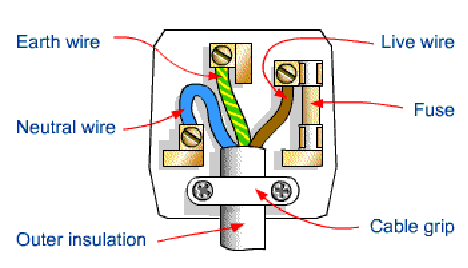The three pin plug is used in the UK for every electrical device run off the 240V mains supply. It consists of a plastic case held together by a screw. Three pins from the underside of the plug are fitted into wall sockets. When the device is switched on, current flows through a brown live wire in the plug, through the device and back through the plug neutral blue wire in the plug. Every plug contains a fuse – a safety device to prevent prevent electrical fires and people receiving electric shocks as far as is possible.

If the current gets too large, indicating a device malfunction or short circuit, the fuse will heat up and melt, breaking the circuit. No current will then flow. Before the fuse is replaced, the cause of the excess current should be investigated.
The yellow/green striped earth wire has a special function, and is only needed when a device has a metal case. This is usual for washing machines and fridges. If a loose wire inside the device touches the case, it may become live and electrocute anyone that touches it. To prevent this, the case is connected to the earth wire, ensuring a complete circuit if ever a loose wire does touch the case. A large current will flow, melt the fuse and cause the device to go dead.
The fuses in plugs come in various ratings – 3A, 5A or 13A. Each rating is designed to allow enough current to reach a device to allow it to operate normally, but to melt if the current becomes excessive before the device is damaged. The fuse rating is found by finding the current required by device and rounding up to the next fuse rating.
Suppose for example that a device has a power rating of 800W. We can find the current requirement using the equation![]() For this device we should use a fuse of 5A.
For this device we should use a fuse of 5A.
